Nice APOD! And thank you, ChatGPT, for that poem on the Hydra Cluster of Galaxies. Not bad for a first(?) attempt. Now, could anyone find that Edgar Allen Poe poem that inspired ChatGPT to write the caption-poem of today's APOD? Art, where art thou?
Art Neuendorffer, expert and connoisseur
of English-language poems of all time.
The only English-language poem on anything astronomical that I know of (except a short piece of
sort of English-language poetry, "Oh freddled gruntbuggly..."), is a poem by Alfred, Lord Tennyson, and the astronomy part is just a few lines of a poem that seemingly goes on forever,
Locksley Hall:
The Pleiades from Tennyson's perspective.
Picture from Burnham's Celestial Handbook.
Many a night from yonder ivied casement, ere I went to rest,
Did I look on great Orion sloping slowly to the West.
Many a night I saw the Pleiads, rising thro' the mellow shade,
Glitter like a swarm of fire-flies tangled in a silver braid.
Beautiful. We may read the next few lines as well:
Here about the beach I wander'd, nourishing a youth sublime
With the fairy tales of science, and the long result of Time;
When the centuries behind me like a fruitful land reposed;
When I clung to all the present for the promise that it closed:
When I dipt into the future far as human eye could see;
Saw the Vision of the world and all the wonder that would be.
Yes, don't we all wonder what the future will be like. Although we are perhaps not so optimistic as Lord Tennyson was (though some are, with dreams of colonizing Mars and beyond).
(And speaking of things that go on forever... it's like trying to find
Halley's Comet in the
Bayeux tapestry. I know it's there! Somewhere!)
As for the Hydra Cluster of Galaxies, the overlapping galaxies of NGC 3314 are indeed a gem:
The Hydra Cluster of Galaxies. NGC 3314 is at top center left.
Credit: Mike Selby and Mark Hanson
Note in the Hubble image how the dark brown dust lanes of the foreground galaxy are seen in sharp silhouette against the background galaxy. But when seen against the blackness of space, the dust lanes become invisible, and we see the young blue stars associated with the arms.
In the picture of the Hydra Cluster of Galaxies by Mark Hanson and Mike Selby, you can see that NGC 3314 is located quite close to the large blue spiral/ring galaxy, NGC 3312. Little NGC 3314 looks like an elongated fat little insect fluttering its translucent wings, doesn't it?
Do go to
Mark Hanson's home page to see more of his and Mike Selby's portrait of the Hydra Cluster and NGC 3314 and NGC 3312! (Although NGC 3314 has been accidentally called NGC 3313 there.)
Anyway. Maybe NGC 3314 is a cosmic counterpart of the glasswing butterflies, like this individual of the
Greta genus of clearwing butterflies:
Ann
 The Hydra Cluster of Galaxies
The Hydra Cluster of Galaxies







